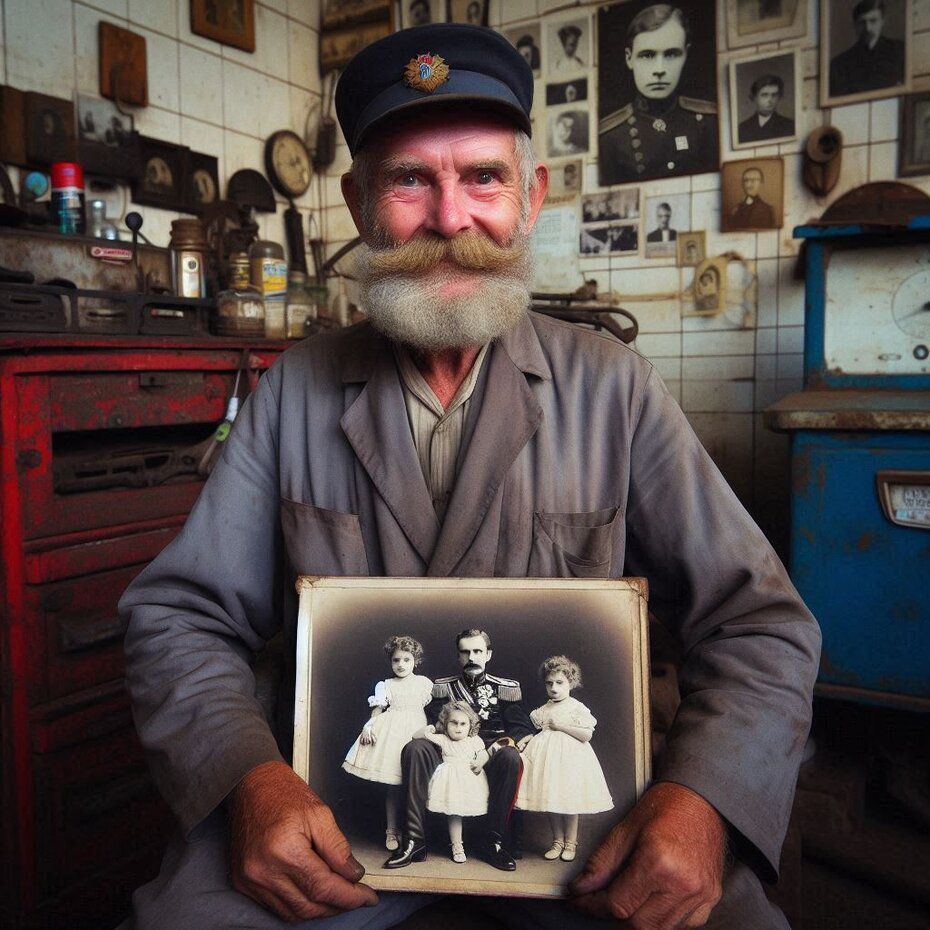Memories of the Tsar of Cuiabá
I look closely at the face of my friend, whom I have learned to love over the years. Alexei is a man with rough features, deeply scarred by a life of adventure and adversity. In the middle of this face marked by deep wrinkles, there are two very blue, clear eyes with an almost childlike beauty. But these eyes don't deceive me: Alexei has a suffering and dense soul that shows in his heavy gait, in his lack of delicacy towards the manifestations of other people's suffering, and in the countless nights he spends drinking vodka, alone and secluded. What does this man think about on the days he devotes to contemplating his soul?

I remember well that day in 1956 when Alexei told me in detail a cloak-and-dagger story that has haunted our neighborhood since the day he opened an O Cruzeiro magazine and burst into tears when he saw the pictures in the lead story. Despair and shame at such a rare manifestation of his emotions made him lock himself in his room to escape the inquisitive eyes of his family and their insistent questions.
“That blue-eyed brute is full of feelings and claims to be a Russian prince!” my wife commented to me the next day. She had come full of energy from the Uruguayan house, her eyes lit up like those of a teenager. When I saw her standing there in front of me, shaking with sweat and her voice altered, I remembered the old days when she still aroused my desire. Now I hardly recognize this woman, who spends her free time complaining about the dirt on my clothes, the price of vegetables at the market and the far-fetched plot of the eight o'clock soap opera. But what she told me that day was a story even more unbelievable than any of these Janete Clair soap operas, and the protagonist is my old drinking buddy!
A few days later, Alexei showed me his registration certificate for the first time since we had met. What I saw in front of me was a very stained and crumpled piece of paper, typewritten and stamped, dated 1938. It said that Alexei Nicolau Romanov, from Petrogado, son of Nicolau Alesandrovich Romanov and Alesandra F. Romanov, had landed as a clandestine immigrant on the Vapor Finlandez “Oriente” in the port of Santos, Brazil in 1925.
Alexei told me that soon after disembarking he went to live in Livramento, in Rio Grande do Sul. However, he soon began to hide his Russian nationality, because in Brazil, as in much of the Western world at the time of the Cold War, the government was hunting down communists. It was there in Livramento that he met his wife, Lindora Pons, an Uruguayan.
After a while, he decided to move to Cuiabá, where he has lived a simple life to this day, working as a mechanic. But on that day in 1956, when he saw the photos of the Romanov family in the article in O Cruzeiro magazine, he said he was engulfed by a sea of emotions stirred up by old memories, long buried in the depths of his memory. What he told me next, and what I'm sharing with you now, was a fantastic story that I've never forgotten.
Alexei was a deeply desired son. Before his birth, Tsar Nicholas II and his wife Alexandra Feodorovna had had four daughters and feared that there would be no prince to ensure the inheritance of the throne. However, just six weeks after his birth, the family's joy at his arrival was disrupted by the discovery that Prince Alexei had inherited from his mother an aggressive form of hemophilia, which afflicted the male descendants of Queen Victoria.
My friend's childhood was marked by several events in which his life hung by a thread, threatened by banal accidents, like those that happen to most children. From the age of three, he had the protection of Rasputin, who was renowned for his supernatural and healing powers. Dr. Feodorov, one of the court physicians, used to tell everyone that, when called by Alexandra, Rasputin would approach Alexei, look at him and spit, stopping the bleeding as if by magic.
In March 1917, when Tsar Nicholas II was deposed, the family was taken to Siberia under the pretext of protecting them from the revolutionary wave. There they lived in relative comfort until the Bolsheviks took power in October of the same year. From then on, the royal family's confinement became more radical: their servants were dismissed and the family was fed the same rations as the soldiers, without the right to coffee or butter.
In April 1918, they were sent to Yekaterinburg, east of the Ural Mountains. At this time, the White Army (anti-communist) was gaining strength and threatening to take Yekaterinburg. In addition, the Czechoslovak Legion was approaching the city to protect the Trans-Siberian Railway under its control.
Desperate at the prospect of the royal family being liberated by enemy armies and used by them to gain popular support, Lenin ordered them to be executed discreetly. One morning in July 1918, Yakov Yurovsky ordered the Romanov family to be gathered in the cellar of the Ipatiev mansion where they lived under the pretext of protecting themselves from capture by the enemy. The shooting of Tsar Nicholas, his wife, his son Alexei and his four sisters, the doctor, the cook, the chaperone and the puppy began without warning. The number of shots fired by the secret police execution squad was so great that it destroyed the wall in front of which they were standing. But the Romanovs took a long time to die, which left their executioners deeply haunted.
When they were expelled from the royal palace a year earlier, they had sewn a huge amount of jewels and diamonds into their underwear to prevent them from being looted. Their reinforced underwear acted as a bulletproof vest, deflecting the shots fired into their chests, which prolonged their suffering. The execution had to be completed with bayonets.
Alexei learned the details of his family's daily life after the deposition of the Tsar and his execution from small talk, relayed to him by his friend Ian. By this time, he had already been sent away from his parents and sisters in an attempt to save his life. Alexei told me that he had fled the palace where he lived with his family the night before the Tsar was deposed, accompanied by a Finnish guard called Ian Arman, who did not know his real identity. In Alexei's place was Gregory Berzof, a boy who was a close friend of Alexei's and physically very similar to him. Alexei considered him almost like a brother.
My friend told me that, that night, he and the guard fled towards the Estonian border and spent several months there staying on the boy's family's small farm. After that, Alexei wandered around various European countries, even starving. He then decided to start working as a sailor and ended up arriving in the port of Santos on a Finnish ship. The man I met spoke 14 languages, knew much of the world and many presidents. The stories about his noble origins matched his unique characteristics.
I learned from a newspaper article that during the years following the execution of the Romanovs, the place where the bones had been buried was kept from the public because of Lenin's fear that it would cause a popular uprising. However, the mystery only caused filmmaker Gely Ryaboy, who worked for the USSR Ministry of the Interior, to become obsessed with the subject and the desire to locate the bones. Gely used his access to the secret archives to track down the son of Yakov Yurovsky, who had led the execution of the Romanovs. Yakov's son provided Gely with some notes in which his father detailed where the bones had been buried, in a swamp near the Ipatiev mansion in Yekaterinburg.
I read in this same report that, in 1979, the place where the bones had been buried was finally discovered. But it wasn't until 1989, during Glasnost, that the Soviet Union publicly admitted the existence of the remains of the royal family. Five years later, a group of experts identified the bones based on DNA analysis. But a new mystery was revealed to the public: the remains of Alexei and one of his sisters had not been found with the rest of his family.
“But of course they couldn't have found Alexei's remains next to the Romanovs', because I'm right here, alive!” he said to me one day, while angrily waving the newspaper. By this time, my friend Alexei and his children had already decided to tell the world their story, in the hope of claiming their right to the royal family's estate. However, a blood test proved that he was not the real Prince Alexei. Despite this, he continued to insist that he was the heir to the Russian imperial throne until 1996, when he was run over by a car at the age of 92.
Eighty years after the execution of the Romanov family, the Russian Orthodox Church ordered the beatification of the Romanovs and the servants who died with them. On the site of the Ipatiev mansion, where they were executed, the Church of the Blood of All Saints of Russia was later built, and an altar was erected on the exact spot where the execution took place.
As I watch your coffin descend into the grave, my dear friend, I remember the stories about a privileged childhood that you told me with your gaze lost in space, while your hands played absent-mindedly with the little gold medal hanging around your neck. You described to me in detail the rooms of the royal palace, located a short distance from St. Petersburg; your childhood games in the palace gardens; your vacation trips on the imperial yacht, to Finland and the Black Sea. When I close my eyes to these shared memories, I can once again smell the warm scent of the sea that invaded me in those days.
I still remember the day when, struck by the incongruity between that little gold medal you were wearing and your rough appearance, I asked you what that jewel was. You told me that the little medal with the image of St. Seraphim of Sarov had been a baptismal gift from your godmother, and that it was thanks to this saint that you had been born.
You are gone forever, but in an act of faith in the truth of your stories, I have decided to keep a photo of you next to the image of St. Seraphim close to my chest, knowing that from now on you will always be with me, protecting me and my family.
P.S.: The remains of Alexei and his sister were discovered in 2007 by a group of amateur archaeologists and their identity was confirmed by DNA analysis. Their bones had been buried 15m from the original graves of their relatives. After much reluctance from the Church, which did not accept the veracity of the DNA analysis, Alexei and his sister were finally beatified.
This story was written freely on the basis of the facts reported in the extensive bibliography on the Romanov family and the alleged “Tsar of Cuiabá”. Only the story of the gold medal was created from ether.
Translated with DeepL.com (free version)
Voltar
